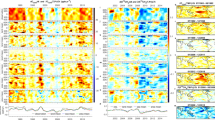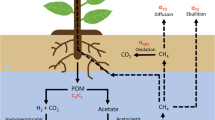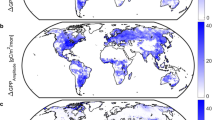Abstract
Atmospheric methane (CH4) increased through much of the twentieth century, but this trend gradually weakened until a stable state was temporarily reached around the turn of the millennium1,2, after which levels increased once more3. The reasons for the slowdown are incompletely understood, with past work identifying changes in fossil fuel, wetland and agricultural sources and hydroxyl (OH) sinks as important causal factors1,4,5,6,7,8. Here we show that the late-twentieth-century changes in the CH4 growth rates are best explained by reduced microbial sources in the Northern Hemisphere. Our results, based on synchronous time series of atmospheric CH4 mixing and 13C/12C ratios and a two-box atmospheric model, indicate that the evolution of the mixing ratio requires no significant change in Southern Hemisphere sources between 1984 and 2005. Observed changes in the interhemispheric difference of 13C effectively exclude reduced fossil fuel emissions as the primary cause of the slowdown. The 13C observations are consistent with long-term reductions in agricultural emissions or another microbial source within the Northern Hemisphere. Approximately half (51 ± 18%) of the decrease in Northern Hemisphere CH4 emissions can be explained by reduced emissions from rice agriculture in Asia over the past three decades associated with increases in fertilizer application9 and reductions in water use10,11.
This is a preview of subscription content, access via your institution
Access options
Subscribe to this journal
Receive 51 print issues and online access
$199.00 per year
only $3.90 per issue
Buy this article
- Purchase on Springer Link
- Instant access to full article PDF
Prices may be subject to local taxes which are calculated during checkout



Similar content being viewed by others
References
Dlugokencky, E. J., Masarie, K. A., Lang, P. M. & Tans, P. P. Continuing decline in the growth rate of the atmospheric methane burden. Nature 393, 447–450 (1998)
Simpson, I. J., Rowland, F. S., Meinardi, S. & Blake, D. R. Influence of biomass burning during recent fluctuations in the slow growth of global tropospheric methane. Geophys. Res. Lett. 33, L22808 (2006)
Dlugokencky, E. J. et al. Observational constraints on recent increases in the atmospheric CH4 burden. Geophys. Res. Lett. 36, L18803 (2009)
Khalil, M. A. K. & Shearer, M. J. in Atmospheric Methane: its Role in the Global Environment (ed. Khalil, M. A. K. ) 98–111 (Springer, 2000)
Bousquet, P. et al. Contribution of anthropogenic and natural sources to atmospheric methane variability. Nature 443, 439–443 (2006)
Forster, P. et al. in Climate Change 2007: The Physical Science Basis (eds Solomon, S. D. et al.) 129–234 (Cambridge Univ. Press, 2007)
Fiore, A. M., Horowitz, L. W., Dlugokencky, E. J. & West, J. J. Impact of meteorology and emissions on methane trends, 1990–2004. Geophys. Res. Lett. 33, L12809 (2006)
Dlugokencky, E. J. et al. Atmospheric methane levels off: temporary pause or a new steady-state? Geophys. Res. Lett. 30 1992 10.1029/2003GL018126 (2003)
Denier van der Gon, H. Changes in CH4 emission from rice fields from 1960 to 1990s. 2. The declining use of organic inputs in rice farming. Glob. Biogeochem. Cycles 13, 1053–1062 (1999)
Li, C. S. et al. Reduced methane emissions from large-scale changes in water management of China’s rice paddies during 1980–2000. Geophys. Res. Lett. 29 1972 10.1029/2002GL015370 (2002)
Frolking, S., Li, C. S., Braswell, R. & Fuglestvedt, J. Short- and long-term greenhouse gas and radiative forcing impacts of changing water management in Asian rice paddies. Glob. Change Biol. 10, 1180–1196 (2004)
Worthy, D. E. J. et al. Decreasing anthropogenic methane emissions in Europe and Siberia inferred from continuous carbon dioxide and methane observations at Alert, Canada. J. Geophys. Res. 114 D10301 10.1029/2008JD011239 (2009)
Cicerone, R. J. & Oremland, R. S. Biogeochemical aspects of atmospheric methane. Glob. Biogeochem. Cycles 2, 299–327 (1988)
Lassey, K. R., Etheridge, D. M., Lowe, D. C., Smith, A. M. & Ferretti, D. F. Centennial evolution of the atmospheric methane budget: what do the carbon isotopes tell us? Atmos. Chem. Phys. 7, 2119–2139 (2007)
Tyler, S. C., Rice, A. L. & Ajie, H. O. Stable isotope ratios in atmospheric CH4: implications for seasonal sources and sinks. J. Geophys. Res. 112, D03303 (2007)
Lowe, D. C., Manning, M. R., Brailsford, G. W. & Bromley, A. M. The 1991–1992 atmospheric methane anomaly: Southern Hemisphere 13C decrease and growth rate fluctuations. Geophys. Res. Lett. 24, 857–860 (1997)
Quay, P. et al. The isotopic composition of atmospheric methane. Glob. Biogeochem. Cycles 13, 445–461 (1999)
Tans, P. P. A note on isotopic ratios and the global atmospheric methane budget. Glob. Biogeochem. Cycles 11, 77–81 (1997)
Etheridge, D. M., Steele, L. P., Francey, R. J. & Langenfelds, R. L. Atmospheric methane between 1000 AD and present: evidence of anthropogenic emissions and climatic variability. J. Geophys. Res. 103, 15979–15993 (1998)
Ferretti, D. F. et al. Unexpected changes to the global methane budget over the past 2000 years. Science 309, 1714–1717 (2005)
Lassey, K. R. Livestock methane emission: from the individual grazing animal through national inventories to the global methane cycle. Agric. For. Meteorol. 142, 120–132 (2007)
van Aardenne, J. A., Dentener, F. J., Olivier, J. G. J., Goldewijk, C. G. M. K. & Lelieveld, J. A 1° x 1° resolution data set of historical anthropogenic trace gas emissions for the period 1890–1990. Glob. Biogeochem. Cycles 15, 909–928 (2001)
Global Anthropogenic Non-CO2 Greenhouse Gas Emissions: 1990–2020 〈http://www.epa.gov/climatechange/economics/downloads/GlobalAnthroEmissionsReport.pdf〉 (United States Environmental Protection Agency, 2006)
Zhuang, Q. et al. Methane fluxes between terrestrial ecosystems and the atmosphere at northern high latitudes during the past century: a retrospective analysis with a process-based biogeochemistry model. Glob. Biogeochem. Cycles 18, GB3010 (2004)
Bloom, A. A., Palmer, P. I., Fraser, A., Reay, D. & Frankenberg, C. Large-scale controls of methanogenesis inferred from methane and gravity spaceborne data. Science 327, 322–325 (2010)
World Rice Statistics 〈http://irri.org/world-rice-statistics〉 (International Rice Research Institute, 2008; accessed, 22 September 2008)
Wassmann, R. et al. Characterization of methane emissions from rice fields in Asia. III. Mitigation options and future research needs. Nutr. Cycl. Agroecosyst. 58, 23–36 (2000)
Water Use Statistics 〈http://www.fao.org/nr/water/aquastat/main/index.stm〉 (Food and Agriculture Organization of the United Nations, 2008; accessed, 22 September 2008)
Huang, Y., Sass, R. L. & Fisher, F. M. A semi-empirical model of methane emission from flooded rice paddy soils. Glob. Change Biol. 4, 247–268 (1998)
Kai, F. M., Tyler, S. C. & Randerson, J. T. Modeling methane emissions from rice agriculture in China during 1961–2007. J. Integr. Env. Sci. 7, 49–60 (2010)
Acknowledgements
We thank the many researchers associated with the laboratories referred to as NOAA, NIWA, UW and UCI who took part in collecting and measuring many thousands of air samples over the years. We also thank P. Bousquet for detailed comments on earlier drafts that improved the manuscript. This work has been funded by NASA grants to S.C.T. (NGT5-30409) and J.T.R. (NNX08AF64G), NSF grants to S.C.T. (ATM 9871077) and J.T.R. (ATM-0628637 and AGS-1021776), and additional support from the W. M. Keck Foundation.
Author information
Authors and Affiliations
Contributions
S.C.T., F.M.K. and D.R.B. carried out CH4, δ13C-CH4 and δD-CH4 measurements. F.M.K., S.C.T. and J.T.R. designed the study. F.M.K. conducted data analysis and performed the model simulations. F.M.K., S.C.T. and J.T.R. wrote the paper. All authors discussed the results and commented on the manuscript.
Corresponding author
Ethics declarations
Competing interests
The authors declare no competing financial interests.
Supplementary information
Supplementary Information
The file contains Supplementary Materials and Methods, Supplementary References, Supplementary Figures 1-16 with legends and Supplementary Tables 1-4. (PDF 2277 kb)
Rights and permissions
About this article
Cite this article
Kai, F., Tyler, S., Randerson, J. et al. Reduced methane growth rate explained by decreased Northern Hemisphere microbial sources. Nature 476, 194–197 (2011). https://doi.org/10.1038/nature10259
Received:
Accepted:
Published:
Issue Date:
DOI: https://doi.org/10.1038/nature10259
This article is cited by
-
Spatial variations in the warming trend and the transition to more severe weather in midlatitudes
Scientific Reports (2021)
-
Fingerprint of rice paddies in spatial–temporal dynamics of atmospheric methane concentration in monsoon Asia
Nature Communications (2020)
-
Observationally derived rise in methane surface forcing mediated by water vapour trends
Nature Geoscience (2018)
-
Revised methane emissions factors and spatially distributed annual carbon fluxes for global livestock
Carbon Balance and Management (2017)
Comments
By submitting a comment you agree to abide by our Terms and Community Guidelines. If you find something abusive or that does not comply with our terms or guidelines please flag it as inappropriate.



